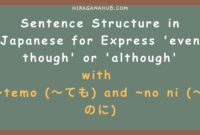How to Change Japanese Verbs to the Te Form (Te-kei)
Hello, welcome back with Akira! Let’s continue learning Japanese grammar. This
time, we will discuss how to change verbs to the te form (te-kei). The method
is quite similar to changing to the ta form that we learned yesterday; simply
replace the ending “a” with “e.” Let’s get started!
What is the importance of the te form? The te form is widely used for various
purposes, such as chaining verbs together, changing verbs to the progressive
form by adding “iru,” or making commands by adding “kudasai/kureru/choudai.”
The te form can also be used to express prohibitions with “wa
ikenai/naranai/dame.” We will cover all of these here, so don’t worry!
Here, I assume you are already familiar with the groups of verbs that have
been previously discussed. If there’s anyone who isn’t, please refer back to
the explanation about verb groups in Japanese. Now, let’s learn how to
conjugate verbs into the te form!
1. Changing Godan Doushi to Te Form:
| Ending | Te Form | Example in Kanji | Pronunciation | Meaning |
|---|---|---|---|---|
| つ (tsu) | って (tte) | 待つ (matsu) | matte | to wait |
| る (ru) | って (tte) | 作る (tsukuru) | tsukutte | to make |
| う (u) | って (tte) | 使う (tsukau) | tsukatte | to use |
| む (mu) | んで (nde) | 飛ぶ (tobu) | tonde | to fly |
| ぶ (bu) | んで (nde) | 読む (yomu) | yonde | to read |
| ぬ (nu) | んで (nde) | 死ぬ (shinu) | shinde | to die |
| く (ku) | いて (ite) | 書く (kaku) | kaite | to write |
| ぐ (gu) | いで (ide) | 泳ぐ (oyogu) | oyoide | to swim |
| す (su) | して (shite) | 話す (hanasu) | hanashite | to speak |
| special | 行って | 行く (iku) | itte | to go |
2. Changing Ichidan Doushi to Te Form:
| Ending | Te Form | Example in Kanji | Pronunciation | Meaning |
|---|---|---|---|---|
| る (ru) | て (te) | 見る (miru) | mite | to see |
| る (ru) | て (te) | 食べる (taberu) | tabete | to eat |
| る (ru) | て (te) | 捨てる (suteru) | sutete | to throw away |
| る (ru) | て (te) | 助ける (tasukeru) | tasukete | to help |
3. Changing Fukisoku Doushi to Te Form:
| Verb | Te Form | Example in Kanji | Pronunciation | Meaning |
|---|---|---|---|---|
| する (suru) | して (shite) | する (suru) | shite | to do |
| 来る (kuru) | 来て (kite) | 来る (kuru) | kite | to come |
Conclusion Table of the Material:
| Regular Verb | Te Form |
|---|---|
| Godan Doushi/KK 1 | |
| tsukau | tsukatte |
| katsu | katte |
| tsukuru | tsukutte |
| asobu | asonde |
| shinu | shinde |
| kaku | kaite |
| hanasu | hanashite |
| Ichidan Doushi/KK 2 | |
| taberu | tabete |
| miru | mite |
| Fukisoku Doushi/KK 3 | |
| suru | shite |
| kuru | kite |
Additionally, negative verbs can also be changed to the te form! Simply change
the い (i) ending to くて (kute). For example: 食べない (tabenai) → 食べなくて
(tabenakute).


